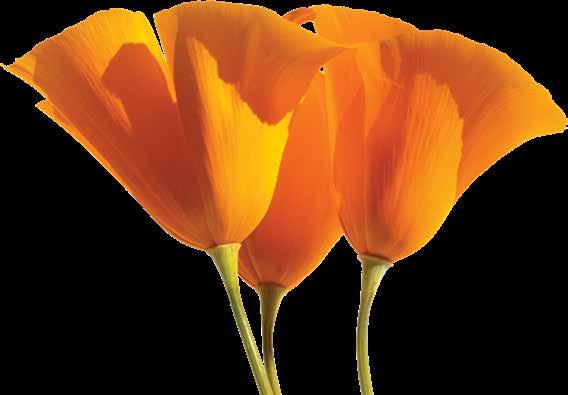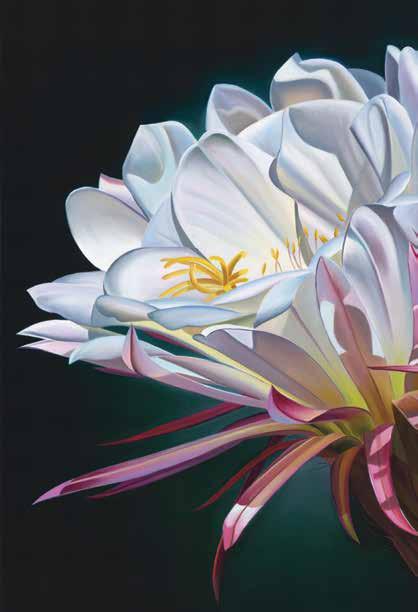
7 minute read
Wallace Desert Rose Garden
Photo by Jeremy Dufault Photography. Visit his Facebook to see more of his photography. www.facebook.com/ jeremydufaultphotography.
Wallace Desert Rose Garden
Advertisement
Text and Photos by Gaylyn Yanke
Although H.B. Wallace had an avid interest in desert plants, Mrs. Jocelyn Wallace was the rose aficionado. She began collecting in 1987, long before many rose cultivars were readily available. Of the 120 plants in the Wallace Desert Garden, twelve were left in Scottsdale. Out of those, only three cultivars are not now represented in the Demonstration Garden at Boyce Thompson Arboretum.
In the middle of February 2017, Boyce Thompson horticulturists and Native Resources staff dug up the Wallace roses, transported them to Boyce Thompson, and put them in the ground—all in one day. With mature plants such as these were, it is important to get the plants back in the ground the same day. Of our 118 rose bushes, there are 46 named cultivars and 26 unnamed Rosa species. Since they were planted, we have lost only three plants.
Most of the Wallace roses are hybrid tea roses, but we also have floribunda, grandiflora, miniature, rock roses, and climbers. “Tea” roses originated in China centuries ago. The name is derived from the fact that the fragrance of the flowers is reminiscent of the smell of brewing tea. The original tea roses were larger shrubs with big flowers that had weak “necks” so the flowers were always nodding down.
In 1867, Guillot of France introduced what would be the first hybrid tea rose. When most gardeners think of roses today, they are thinking of these hybrids, with their classic, long stems and perfect individual blooms that make for good cut flowers. They are hardy in Zones 4-9 and bloom repeatedly throughout the season. They usually grow to 4 to 5 feet tall and like all roses, prefer full sun. My favorite rose at Boyce Thompson Arboretum, the Rosa John F. Kennedy, was introduced in 1964, with gorgeous white double blooms carrying a delicious, fruity-licorice aroma. Last fall’s bloom resulted in interesting speckled white with deep red spots.
The Rosa Wildfire is a vigorous grower and memorable cut flower; it provides dazzling blooms from late spring to early summer. Wildfire™ starts off with classically elegant pointed, ovoid buds that are yellow with orange edging. Once they open, they reveal 35 thick, velvety petals of a rich orange with a glowing yellow reverse. For the most part, these 4-inch blooms appear singly atop long, sturdy, 16- to 20-inch stems, making them excellent, long-lasting cut flowers. Wildfire™ grows to a mature size of up to 6 feet high and 3 to 4 feet wide, needing only well-drained soil in full sun, and removal of spent flowers in order to encourage re-bloom. Hardy in Zones 6-9.
Another favorite is the Rosa Gemini, the 2000 All-America Rose Selection winner. Blooms exhibit perfect form with distinctive color patterning that has deep salmon coloring at the edges through all shades of pink and creamy white. Gemini’s blooms reach 4 to 5 inches wide, borne on straight, strong 20-inch stems that help extend the flowering time by a few days. High centered and packed with 25 to 30 petals, the flowers unfurl slowly, their form perfect whether they are just beginning to open from long, plump buds or fully extended to reveal the play of colors washed across their splendid petals.
Expect this remarkable rose—both disease resistant and heat tolerant— to grow quickly into a well-branched shrub 5 to 6 feet high and 4 to 5 feet wide in the sunny garden, and to fill your vases all season long with memorable blooms.
Floribunda Roses were introduced in 1930. The original floribundas were the result of crosses of Hybrid Tea roses and an old-fashioned class of rose called Polyanthas. These are relatively compact bushes with excellent hardiness and disease resistance that produce large clusters of blooms. They are continuous bloomers and have the same color range as the Hybrid Teas. Floribundas will adapt to a wide range of soil and temperature conditions. They are great in containers, reaching heights of only 3 to 4 feet. They can be single or double blooms and come in a wide range of colors.
My favorite of the Wallace roses is an All-American Rose Selections Award winner with chocolate-brown tones and hints of smoke, red and purple, Rosa Hot Cocoa™. It is a unique, very easy-to-grow floribunda that offers fully double blooms 3½ inches wide. Densely branched and very cold-hardy, this rose repeats all summer long, offering great waves of color for garden and vase.

Rosa Blaze of Glory

Rosa Gemini

The 'Lagerfeld'

Rosa John F. Kennedy
Another favorite of this type is the Rosa Disneyland. This compact floribunda blooms from early to late summer. Disneyland’s 3-inch flowers open from pretty pointed, ovoid buds to reveal 30 to 35 perfectly formed petals, the brilliantly colored blossoms with copper, apricot, orange, and pink tones arising in small clusters with 5-inch stems that stand out boldly against the tall, upright, well-branched habit of attractive dark green foliage and perfume the air with a light, spicy fragrance. Reaching a very manageable size of 26 to 30 inches high and 20 to 24 inches wide, this rose is cold hardy, disease resistant, humidity tolerant, pest resistant, and heat tolerant. Plant Disneyland® in full sun in well-drained soil in Zones 5-9.
The grandiflora rose is a hardy cross between a floribunda and a hybrid tea. They have large blooms that are clustered on long stems, making them good for cut flowers. They have the same hardiness zones and also bloom repeatedly. They are normally without fragrance. The ‘Queen Elizabeth’ was the first grandiflora rose to be developed, and is one of the earliest introduced roses in the Wallace collection. Introduced in 1954, the Queen Elizabeth is a sturdy tall grower reaching 6 to 7 feet tall with lots of pink blooms.

Rosa Gemini
One of my favorites in our garden is the Lagerfeld. There is no other color quite like 'Lagerfeld' in the rose garden, especially at twilight when the silvery highlights of the lavender-mauve blooms seem to glow. This grandiflora is notable for its large 4- to 5-inch flower size, its exquisite high-centered, exhibition quality form, and its powerful spicy-sweet scent. The blooms have the classic hybrid tea form, boasting about 30 petals and arising in great flushes all season. Expect nearly a dozen blooms on every stem, for weeks of beauty and marvelous scent. Within a season or two, 'Lagerfeld' reaches its mature size of 4 to 5 feet high and 3 to 4 feet wide. Medium green foliage, glossy and substantial, keeps the shrub attractive from spring through fall in the sunny garden.
Climbing roses obviously need to grow on a trellis or arbor and can grow 6-20 feet in height. Canes can be tied in place for positional training. One such in our collection is the Rosa Blaze of Glory, introduced in 1995; it is a large double-flowered climber with quartered, double ruffled blooms, 4 inches wide, and occurring in large clusters. Blaze of Glory is heat resistant and able to retain its brightly hued blooms regardless of the weather. Coral to orange in color, with pink edges, blooms turn pinker as the bloom matures. This variety also carries a delicate musky fragrance. This rose blooms from early to late summer and is hardy in Zones 5-9.

The 'Lagerfeld'
Miniature roses are perfectly formed roses, but range in height from 3" to 18". They are hardy and re-bloom easily, coming in all modern rose colors. They make excellent additions for small gardens and container gardens. We have one named cultivar in our collection, the Rosa Funny Girl. This miniature was introduced in 1982 by William Warriner, a cross between the Bridal Pink and Fire Princess. Light pink 2 inch clusters of blooms with a mild fragrance grow on a short 2-3-foot bushy shrub. Optimally grown in Zone 6 or warmer, this rose blooms continuously from spring to fall.
Preston Cox will be growing some of these roses from cuttings. If a cooler summer prevails, watch for Wallace rose varieties in the Spring 2020 Plant Sale. If it heats up, you rose aficionados will have to wait until the Fall Sale.





